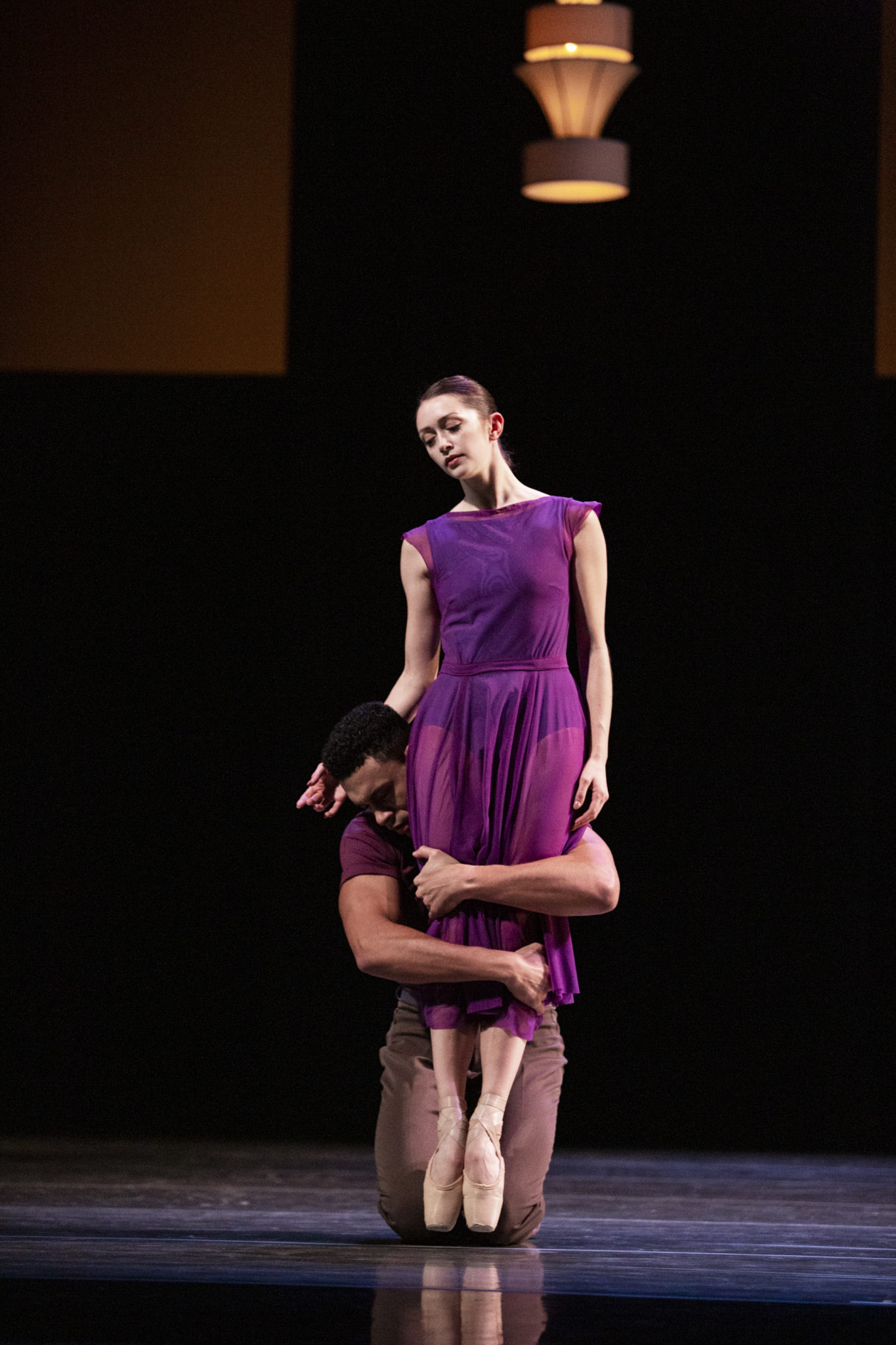The second program of Pacific Northwest Ballet’s season is Locally Sourced, a mixed rep comprising three world premieres by local choreographers: Eva Stone, Donald Byrd, and Miles Pertl. Of the three, Donald Byrd is the most well-known. Byrd is the Tony-nominated (The Color Purple) and Bessie Award-winning (The Minstrel Show) choreographer in charge of the contemporary dance company Spectrum Dance Theater. I can’t remember when I first became aware of Donald Byrd, or which of his works I first saw. But by the time I saw Christopher D’Ariano perform his piece Wake the Neighbors at Next Step, I already knew I liked his work. So I was looking forward to Love and Loss, and it did not disappoint.
Natural and Normy
One of the things I love about Byrd is how naturalistic his dances are. The costumes for Love and Loss are as normcore as ballet can get, with the men in khakis and button-downs, the women in plain dresses. The effect is to trick you into thinking these are just normal people. If they move in ways that are unreal to the rest of us, it’s almost as if we’re seeing their thought bubbles instead of their highly trained bodies.
But it’s not just the costumes that look natural. Byrd’s ballets aren’t any simpler than other choreographers’, but in his hands, the classical movements blend into gestures that seem unscripted. When dancers reach for each other, it doesn’t feel balletic, it feels like someone reaching out for another. Things don’t feel choreographed; the dancers always look like they just felt like doing that.
Love and Loss
Byrd is known for tackling hard issues like race and climate change – last summer he did a piece about lynching. But he said that for this PNB commission, he wanted to focus on beauty and the sublime. The set was just a couple of big panels that served to frame dancers waiting for their turn. The piece is named after the music, Songs of Love and Loss by Emmanuel Witzthum, a friend of Byrd’s from Israel. The score is a near seamless combination of orchestral strings and electronics.
bandcamp width=100% height=120 album=85720201 size=large bgcol=ffffff linkcol=0687f5 tracklist=false artwork=small
Byrd didn’t provide any context or comments about the ballet for the program, but they were hardly missed because this was the most narrative of the three ballets. Each of the three movements to the ballet told the story of one or more couples engaged in a romantic relationship that ends in loss. And like some of my favorite albums, the ballet made you feel like you remembered living those experiences yourself, even if you never have.
Even in the corps de ballet parts, where at first it seems like everyone is moving the same way, a few individuals are doing their own thing. It’s not the hierarchy of a traditional ballet, with the soloists doing fancy stuff. It’s just that even when you’re not that different from everyone else, everyone has moments that belong only to themselves.
And Feminism
So Love and Loss was beautiful and sublime, but it wasn’t quite true that he left equal rights at home. Like many (most?) ballets, Love and Loss told stories about love affairs. But these were not cliched, swooning ballet romances full of hesitant approaches and pointless separations. In Love and Loss, women are not waiting for their prince to come. They setting the boundaries and maintain their separate agency throughout. Even in the lifts, the women hold themselves rigid, making it obvious that the men aren’t the only ones working.

First, Lucien Postlewaite is literally struck down by love at first sight. Throughout the entire movement, Postlewaite, who always looks so suave on stage, is desperate and clumsy, obviously more invested than she is. He places a hand on her shoulder and she flinches. He slumps, walks away, dejected. Leta Biasucci is … interested. But in the end, she’s just not that into him, and moves on.
Amanda Morgan is in a love triangle with Ryan Cardea and Price Suddarth. She has no time for one of them; might consider the other. But ultimately she decides, “Nah, I’m good,” and tiptoes off the stage. (You can almost hear the tinkley Looney Tunes tip-toe noise as she floats away.)
Joshua Grant and Christopher D’Ariano have their own issues on one side of the stage; the men make up just one of several couples on the stage, each one wrapped up in their own scenario of love and loss. Whatever the shape of the relationship, and however it’s lost, it’s all beautiful and sublime when Byrd tells the story.
Love and Loss
World Premiere
Music: Emmanuel Witzthum
Choreography: Donald Byrd
Costume Design: Doris Black
Lighting Design: Randall G. Chiarelli
Assistants to the Choreographer: Nia-Amina Minor, Emily Pihlaja, Andrew Pontius, and Fausto Rivera
Performance Details
November 8 – 17, 2019
Marion Oliver McCaw Hall
Remaining performances:
November 14, 15 & 16 at 7:30 PM
November 17 at 1:00 PM
Tickets ($37-$190) are available online.
Subject to availability, tickets are also available 90 minutes prior to show times at McCaw Hall.
Cast I Saw
Madison Rayn Abeo*
Leta Biasucci*
Angelica Generosa*
Cecilia Iliesiu*
Amanda Morgan*
Clara Ruf Maldonado*
Sarah-Gabrielle Ryan*
Ryan Cardea*
Dammiel Cruz*
Christopher D’Ariano*
Kyle Davis*
Joshua Grant*
Benjamin Griffiths*
Dylan Wald*
Mark Cuddihee*
Christian Poppe*
Lucien Postlewaite*
Price Suddarth*
Ezra Thomson*
Indicates first time in role * (of course, because it’s a world premiere, that’s everybody).




About the author